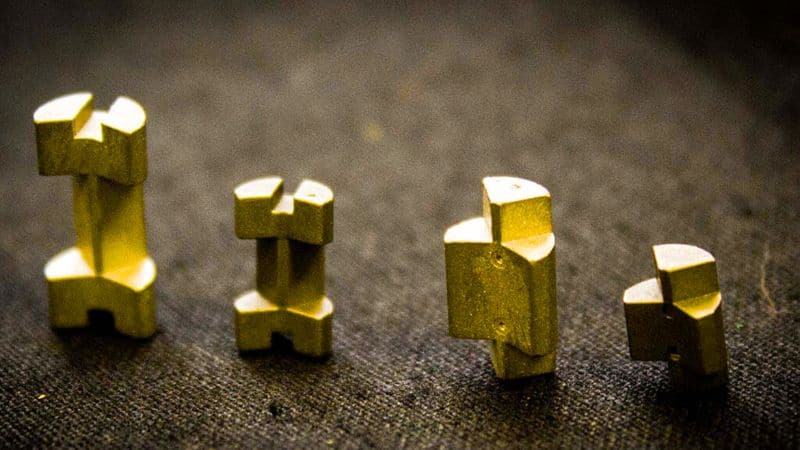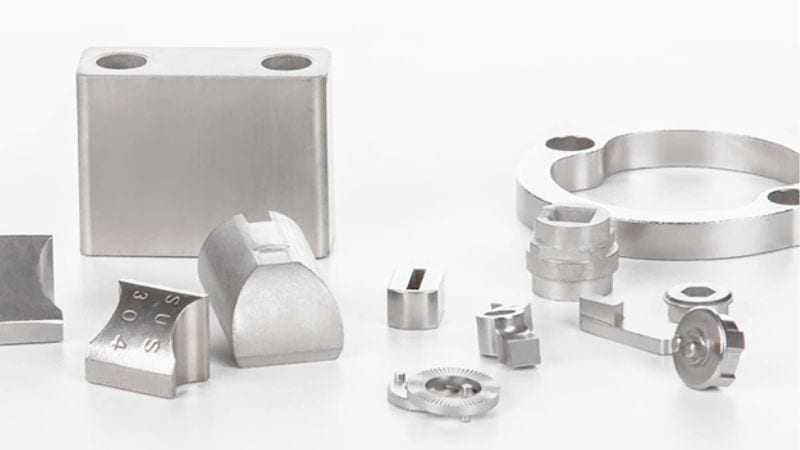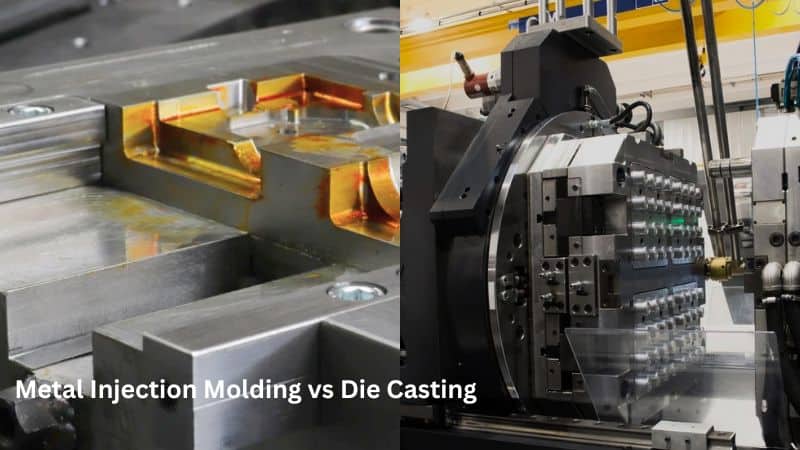Key Takeaways
| Category | Metal Injection Molding (MIM) | Die Casting |
|---|---|---|
| Process | 1. Metal powder mixed with binder. 2. Injected into mold. 3. Debinding. 4. Sintering. |
1. Molten metal forced into mold under high pressure. 2. Cooled and solidified. |
| Materials | Stainless steel, titanium, copper, tungsten alloys, ceramics. | Non-ferrous metals (aluminum, zinc, magnesium, copper alloys). |
| Part Complexity | High complexity, intricate geometries, fine details | Moderate complexity; limited by molten metal flow and draft angles. |
| Wall Thickness | Very thin walls (down to 0.5 mm). | Thicker walls (typically 1–2.5 mm minimum). |
| Tolerances | Tight tolerances (±0.3–0.5% of dimension). | Moderate tolerances (±0.5–1% of dimension). |
| Surface Finish | Smooth but may require secondary finishing (e.g., polishing, coating). | High-quality as-cast finish; minimal post-processing. |
| Cost Factors | High tooling and material (powder) costs; economical for complex parts in bulk. | Lower material costs; high tooling costs; cost-effective for high-volume runs. |
| Typical Applications | Medical devices, firearm components, micro-gears, watch parts. | Automotive components (e.g., housings), consumer electronics, plumbing fixtures. |
| Post-Processing | May require machining, heat treatment, or coating. | Trimming, deburring, surface treatments (e.g., plating, painting). |
| Advantages | – Complex geometries. – High precision. – Wide material range. – Near-net shape. |
– Fast cycle times. – Excellent surface finish. – Cost-effective for large volumes. |
| Disadvantages | – High upfront costs. – Limited part size. – Longer lead time for sintering. |
– Limited to lower-melting-point metals. – Porosity in parts. – Less design flexibility. |
What is Metal Injection Molding
Metal Injection Molding is a manufacturing technique where metal powder is mixed with a plastic binder to form a “feedstock.”
The process begins when this feedstock is injected into a mold cavity under pressure.
Once cooled, you get what’s called a “green part.”
Next comes debinding, where most of the plastic binder is removed using heat or chemicals. This leaves you with a “brown part” that’s fragile but holds its shape.
The final step is sintering. Your parts are heated in a controlled furnace to temperatures below the melting point of the metal.
This causes the metal particles to bond together, creating a dense, strong part that’s about 95-99% as dense as the original metal.
Materials Used in MIM
MIM works with a wide range of metals and alloys. The most common materials include stainless steel, which offers excellent corrosion resistance and strength for your products.
Low alloy steels are popular for their good mechanical properties and lower cost in automotive and industrial applications.
Other common MIM materials include:
- Titanium alloys (lightweight, biocompatible)
- Tool steels (hard-wearing)
- Tungsten alloys (high density)
- Copper alloys (good thermal conductivity)
The metal powders used in MIM must have specific characteristics. They need to be very fine (typically 5-20 micrometers) and fairly spherical in shape to flow properly during injection and sinter effectively.
Basics of Die Casting
Die casting is a manufacturing process where molten metal is forced into a mold cavity at high pressure.
Die casting comes in two main types: hot chamber and cold chamber. Hot chamber die casting works well for low melting point metals like zinc and magnesium.
Cold chamber die casting is better for metals with higher melting points like aluminum and copper alloys. The metal must be ladled into the injection chamber for each cycle.
Both techniques use metal dies (molds) made from tool steel. The process creates parts with thin walls, complex shapes, and tight tolerances.
Metals Used in Die Casting
Aluminum is the most common die casting material, making up about 80% of all die cast parts. It offers an excellent strength-to-weight ratio and good corrosion resistance.
Zinc alloys are another popular choice. They flow easily when molten and can fill very thin sections.
Other suitable metals include:
- Magnesium (lightest structural metal)
- Copper alloys (high strength and conductivity)
- Lead and tin (for specialized applications)
Comparing MIM and Die Casting Processes

Key Differences
MIM uses metal powder mixed with a plastic binder that gets burned out later in the process. This differs significantly from die casting, which uses molten metal injected directly into molds.
The dimensional tolerances between these processes vary. MIM typically achieves tighter tolerances and can produce more complex geometries with finer details.
Material options differ too. MIM works with a wide range of metals including stainless steel and titanium. Die casting mainly uses non-ferrous metals like aluminum, zinc, and copper alloys.
Advantages and Disadvantages
MIM Advantages:
- Higher complexity capabilities
- Better surface finish
- Greater design flexibility
- Works with more metal types
- Produces smaller, more intricate parts
Die Casting Advantages:
- Faster production speeds
- Lower cost for larger parts
- More durable tooling (dies last longer)
- Better for high-volume production
- Simpler overall process
Cost Considerations
Initial tooling costs for both processes can be substantial. Die casting typically has higher upfront costs for equipment but lower per-part costs at high volumes.
MIM usually costs more per part at lower volumes but becomes competitive at medium volumes for complex parts. The material efficiency of MIM can offset some costs since it wastes less metal than die casting.
When choosing between these processes, you should consider:
- Production volume needed
- Part complexity and size
- Material requirements
- Budget constraints
- Timeline
Part size strongly influences cost decisions—die casting becomes more economical for larger parts, while MIM is often more cost-effective for smaller, complex components.
Applications in Different Industries

MIM Applications
MIM parts usually used in medical devices like surgical instruments and dental implants where precision is crucial.
In the firearms industry, MIM produces intricate trigger assemblies and other small components that require strength and precision.
Automotive applications include fuel injection components, turbocharger parts, and sensors. MIM’s ability to create complex geometries with high material density.
The aerospace industry uses MIM for specialized brackets, sensor housings, and other components where weight reduction is important but strength cannot be compromised.
Die Casting Applications
Die cast parts are used in consumer electronics housings, from laptop frames to camera bodies.
In the automotive sector, die casting produces engine blocks, transmission cases, and structural components.
Home appliances feature die cast parts in washing machines, refrigerators, and small kitchen appliances.
Lighting fixtures and furniture hardware often use die casting for decorative elements that require both strength and aesthetic appeal.
Material Properties and Product Quality
The materials used in both processes directly impact the strength, detail, and finish of your final products.
Strength and Tolerance
Metal injection molding (MIM) typically creates parts with higher density and better mechanical properties than die casting. With MIM, you can achieve tolerances as tight as ±0.3% of the dimension size, making it perfect for precision components.
Die casting produces parts that are slightly less dense but still offer good strength for many applications. The tolerance range usually falls between ±0.5–1% depending on the part size.
MIM parts undergo sintering, which reduces porosity and increases strength. This makes them suitable for high-stress applications like medical devices and aerospace components.
Surface Finish and Detail
MIM produces parts with excellent surface finish, often requiring minimal post-processing. You can achieve surface roughness values as low as 0.8μm Ra (roughness average).
Die casting also offers good surface finish but typically requires more secondary operations to achieve the same quality level as MIM parts.
With MIM, you can create intricate details including thin walls (as thin as 0.5mm), complex internal geometries, and fine textures that would be difficult with die casting.
Die cast parts can feature good detail but struggle with very small features and extremely thin walls.
MIM lets you incorporate threading, small holes, and detailed logos directly into the part without secondary operations.
Cooperate With Moldiecasting
At Moldiecasting, we specialize in high-pressure die casting. Unlike the MIM process, which relies on metal powder and a lengthy sintering process, our die casting method ensures rapid cooling, minimal waste, and seamless eject of finished parts—ideal for high-volume production.
Whether you’re comparing injection molding and die casting or weighing material options, our design flexibility and expertise in handling diverse raw materials guarantee tailored solutions.
Ready to optimize your next project? Contact us today to explore how our metal casting expertise, advanced casting machines, and commitment to quality can deliver cost-effective, high-performance results. Visit moldiecasting to turn your vision into reality.

